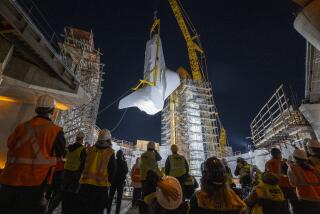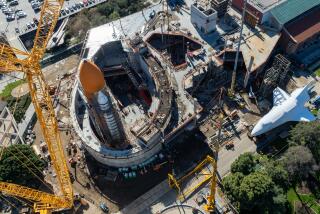Last leg of a flight from space
NASA’s Discovery space shuttle will get a ride back to Florida --probably Thursday -- atop a 747 jumbo jet carrier. After the shuttle touched down at Edwards Air Force Base on Aug. 9, it was moved to a gantry-like tower at the base’s Dryden Flight Research Center for preparations.
*
Loading the Discovery onto the 747
Shuttle is hoisted and receives a visual inspection. Residual fuel is flushed from engine valves and plumbing; other toxic substances removed.
Technicians secure aerodynamic 10,000-pound aluminum tail cone that helps eliminate drag during flight back to Florida.
Engine nozzles and elevons are locked in place. Discovery is raised 60 feet to accommodate mounting on 747 shuttle carrier.
The 747 is towed into place and the shuttle is attached to three struts that match fittings on the external fuel tank used at launch.
*
Flight to Florida
Approximate flight path
Discovery’s route home will probably include three fuel stops before landing in Florida. The crew is two pilots and two engineers.
Typical cruise level: 24,000-26,000 feet
With shuttle: 13,000-15,000 feet
Carrier speed is limited to about 290 mph. It flies at lower altitudes where the air temperature is no colder than 15 degrees to help prevent fuel lines in the rear of the shuttle from freezing.
*
The carrier jet
Shuttle return flights generally leave at sunrise or shortly thereafter. Flying about 50 miles ahead of it will be a pathfinder plane checking for weather disturbances and rerouting the shuttle carrier if necessary. About 30 crew members fly with the pathfinder and inspect the shuttle for damage at each stop along its flight. A look at the shuttle carrier:
Tailcone promotes smoother air flow and dampens tail vibrations on the 747.
Extra vertical stabilizers improve stability in turns.
Upgraded engines lift the orbiter’s 228,000 pounds.
Orbiter is supported by three struts, one at the front and one on each side at the rear.
1,400 pounds of iron ballast fastened to cabin floor.
Seats retained for occasional passengers
Interior furnishings removed
7,000 pounds of gravel ballast stored in cargo hold.
Engines adjust position to allow for tailcone
Small internal jet engine helps main engines start.
*
Source: NASA Dryden Flight Research Center. Graphics reporting by Tom Reinken
Recent regional explainer graphics are available at latimes.com/localgraphics
More to Read
Sign up for Essential California
The most important California stories and recommendations in your inbox every morning.
You may occasionally receive promotional content from the Los Angeles Times.










